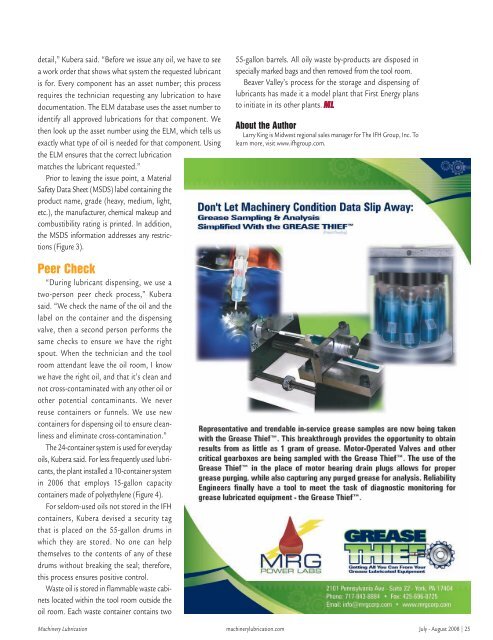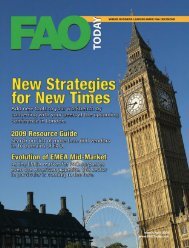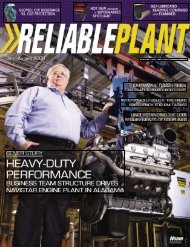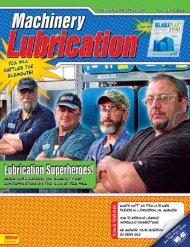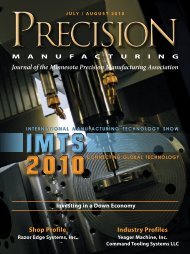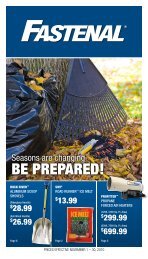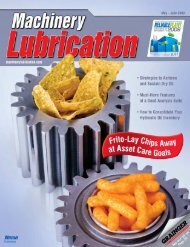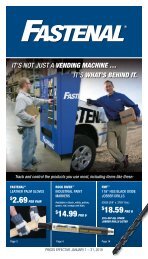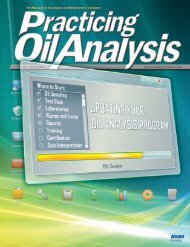Machinery Lubrication July August 2008
Machinery Lubrication July August 2008
Machinery Lubrication July August 2008
You also want an ePaper? Increase the reach of your titles
YUMPU automatically turns print PDFs into web optimized ePapers that Google loves.
detail,” Kubera said. “Before we issue any oil, we have to see<br />
a work order that shows what system the requested lubricant<br />
is for. Every component has an asset number; this process<br />
requires the technician requesting any lubrication to have<br />
documentation. The ELM database uses the asset number to<br />
identify all approved lubrications for that component. We<br />
then look up the asset number using the ELM, which tells us<br />
exactly what type of oil is needed for that component. Using<br />
the ELM ensures that the correct lubrication<br />
matches the lubricant requested.”<br />
Prior to leaving the issue point, a Material<br />
Safety Data Sheet (MSDS) label containing the<br />
product name, grade (heavy, medium, light,<br />
etc.), the manufacturer, chemical makeup and<br />
combustibility rating is printed. In addition,<br />
the MSDS information addresses any restrictions<br />
(Figure 3).<br />
55-gallon barrels. All oily waste by-products are disposed in<br />
specially marked bags and then removed from the tool room.<br />
Beaver Valley’s process for the storage and dispensing of<br />
lubricants has made it a model plant that First Energy plans<br />
to initiate in its other plants.<br />
About the Author<br />
Larry King is Midwest regional sales manager for The IFH Group, Inc. To<br />
learn more, visit www.ifhgroup.com.<br />
Peer Check<br />
“During lubricant dispensing, we use a<br />
two-person peer check process,” Kubera<br />
said. “We check the name of the oil and the<br />
label on the container and the dispensing<br />
valve, then a second person performs the<br />
same checks to ensure we have the right<br />
spout. When the technician and the tool<br />
room attendant leave the oil room, I know<br />
we have the right oil, and that it’s clean and<br />
not cross-contaminated with any other oil or<br />
other potential contaminants. We never<br />
reuse containers or funnels. We use new<br />
containers for dispensing oil to ensure cleanliness<br />
and eliminate cross-contamination.”<br />
The 24-container system is used for everyday<br />
oils, Kubera said. For less frequently used lubricants,<br />
the plant installed a 10-container system<br />
in 2006 that employs 15-gallon capacity<br />
containers made of polyethylene (Figure 4).<br />
For seldom-used oils not stored in the IFH<br />
containers, Kubera devised a security tag<br />
that is placed on the 55-gallon drums in<br />
which they are stored. No one can help<br />
themselves to the contents of any of these<br />
drums without breaking the seal; therefore,<br />
this process ensures positive control.<br />
Waste oil is stored in flammable waste cabinets<br />
located within the tool room outside the<br />
oil room. Each waste container contains two<br />
<strong>Machinery</strong> <strong>Lubrication</strong> machinerylubrication.com <strong>July</strong> - <strong>August</strong> <strong>2008</strong> 25


